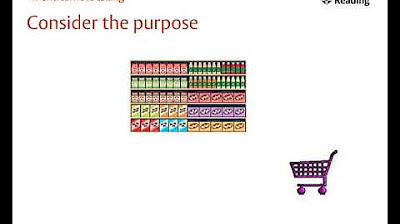Note-Taking from Readings
Summary
TLDRThis video highlights three essential steps for effective reading and note-taking: previewing, encoding, and elaborating. First, previewing involves scanning headings, summaries, and figures to prepare your brain for new information. Second, encoding focuses on actively digesting the text by taking concise notes and avoiding excessive highlighting. Finally, elaborating deepens understanding by organizing information creatively, relating it to existing knowledge, and asking reflective questions. These steps enhance retention and make reading more efficient and impactful.
Takeaways
- 📘 **Previewing is Essential**: Previewing helps the brain prepare to receive and organize information more effectively.
- 🔍 **Preview Techniques**: Look at headings, subheadings, summaries, and tables to get a sense of what the chapter will cover.
- 📝 **Encoding Through Active Note-Taking**: Highlighting and underlining are not as effective as actively engaging with the text by summarizing it in your own words.
- ⏸️ **Pause and Reflect**: After reading a section, stop and reflect on the main and supporting points to aid in memory retention.
- 📋 **Outline Format**: Use an outline format for notes, which can be done in a textbook or, preferably, in a digital platform like Evernote.
- 📲 **Digital Note-Taking Advantages**: Using a digital platform allows for easy access to notes across devices and reduces the need for rereading.
- 🖍 **Minimal Highlighting**: If you must highlight, do so minimally to identify key points, as over-highlighting indicates a lack of deep processing.
- 🤔 **Elaboration Through Questioning**: Deepen your understanding by asking questions about the information, such as alternative ways to organize it or how it relates to prior knowledge.
- 🔄 **Visual Representation**: Consider if the information would be better understood as a picture, diagram, or table showing similarities and differences.
- 📈 **Sequential Understanding**: Determine if the information is better understood as a sequence or series of steps.
- ❓ **Continual Inquiry**: Keep asking what questions the reading answers and what questions remain to foster deeper encoding and comprehension.
Q & A
What are the three major steps in taking notes from readings?
-The three major steps are previewing, encoding (digesting), and elaborating on the information after reading.
Why is previewing important before reading?
-Previewing prepares the brain to organize incoming information, making it easier to retain and understand the material.
What are some ways to preview a text before reading?
-Some ways include reading chapter headings, subheadings, summaries, considering questions listed in the chapter, and reviewing tables and figures.
What is the downside of highlighting or underlining while reading?
-Highlighting and underlining are often overused, and students may fail to actively engage with the material, leading to shallow processing and poor retention.
How should you take notes to better engage with the reading material?
-Instead of highlighting, pause after reading short sections to identify the main and supporting points. Write these down in your own words using the fewest words possible, preferably in an outline format.
What is the benefit of writing notes in a digital platform like Evernote?
-Digital platforms allow easy access to notes across devices and consolidate notes in one place for more efficient review.
What does it mean if you're highlighting a lot of text?
-It may indicate that you're not digesting the material properly and need to focus on understanding the key points rather than simply marking large portions of the text.
What is the purpose of the third step, elaboration, in note-taking?
-Elaboration deepens the encoding of information by encouraging you to ask questions and think critically about the material, making it more likely that you’ll understand and remember it.
What are some ways to elaborate on the information after reading?
-You can organize the information in different ways (e.g., as a diagram, table, or sequence), connect it to what you already know, and ask questions about unanswered points.
How does asking questions help in the process of elaborating on information?
-Asking questions forces you to think more deeply about the content, leading to better understanding and retention of the material.
Outlines

Cette section est réservée aux utilisateurs payants. Améliorez votre compte pour accéder à cette section.
Améliorer maintenantMindmap

Cette section est réservée aux utilisateurs payants. Améliorez votre compte pour accéder à cette section.
Améliorer maintenantKeywords

Cette section est réservée aux utilisateurs payants. Améliorez votre compte pour accéder à cette section.
Améliorer maintenantHighlights

Cette section est réservée aux utilisateurs payants. Améliorez votre compte pour accéder à cette section.
Améliorer maintenantTranscripts

Cette section est réservée aux utilisateurs payants. Améliorez votre compte pour accéder à cette section.
Améliorer maintenantVoir Plus de Vidéos Connexes
5.0 / 5 (0 votes)






